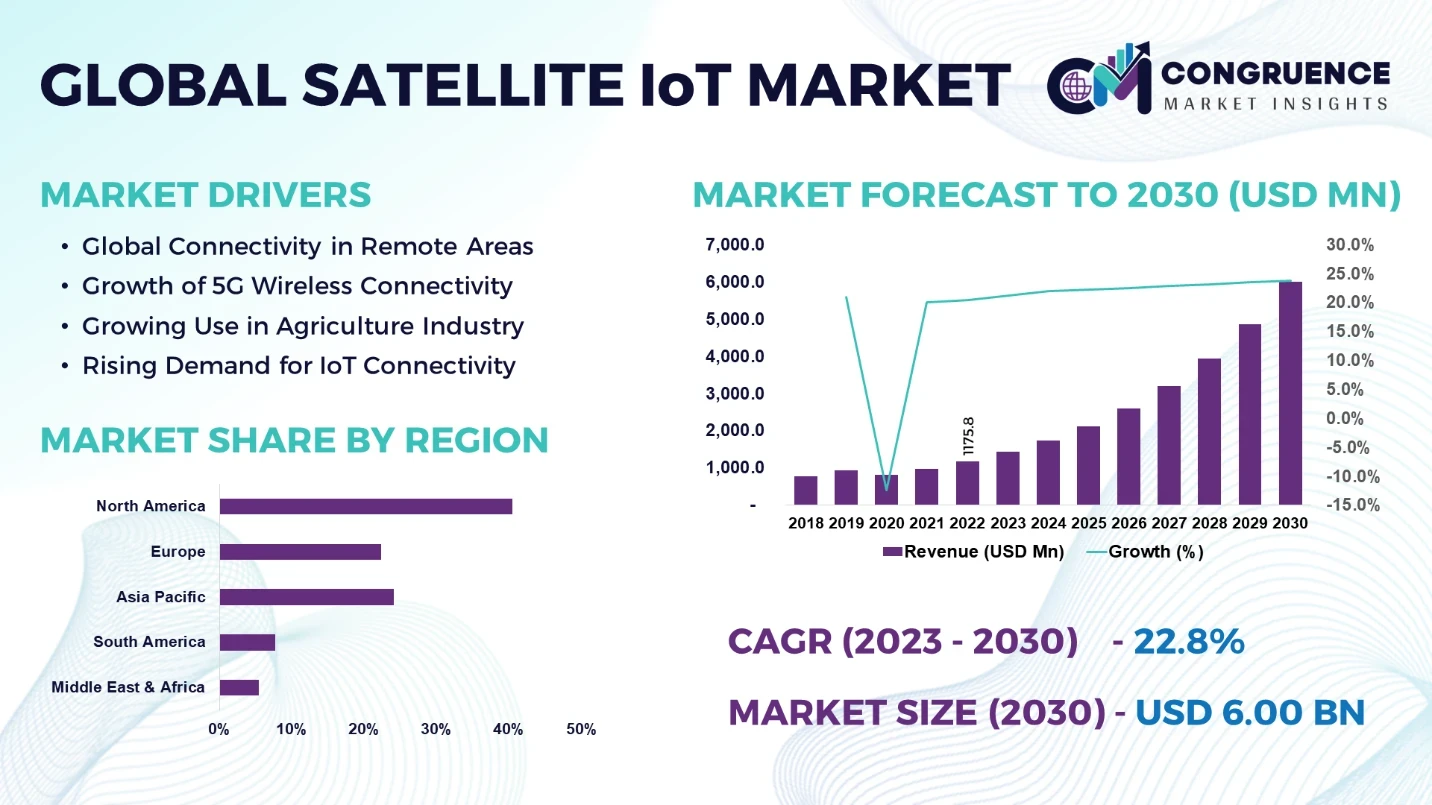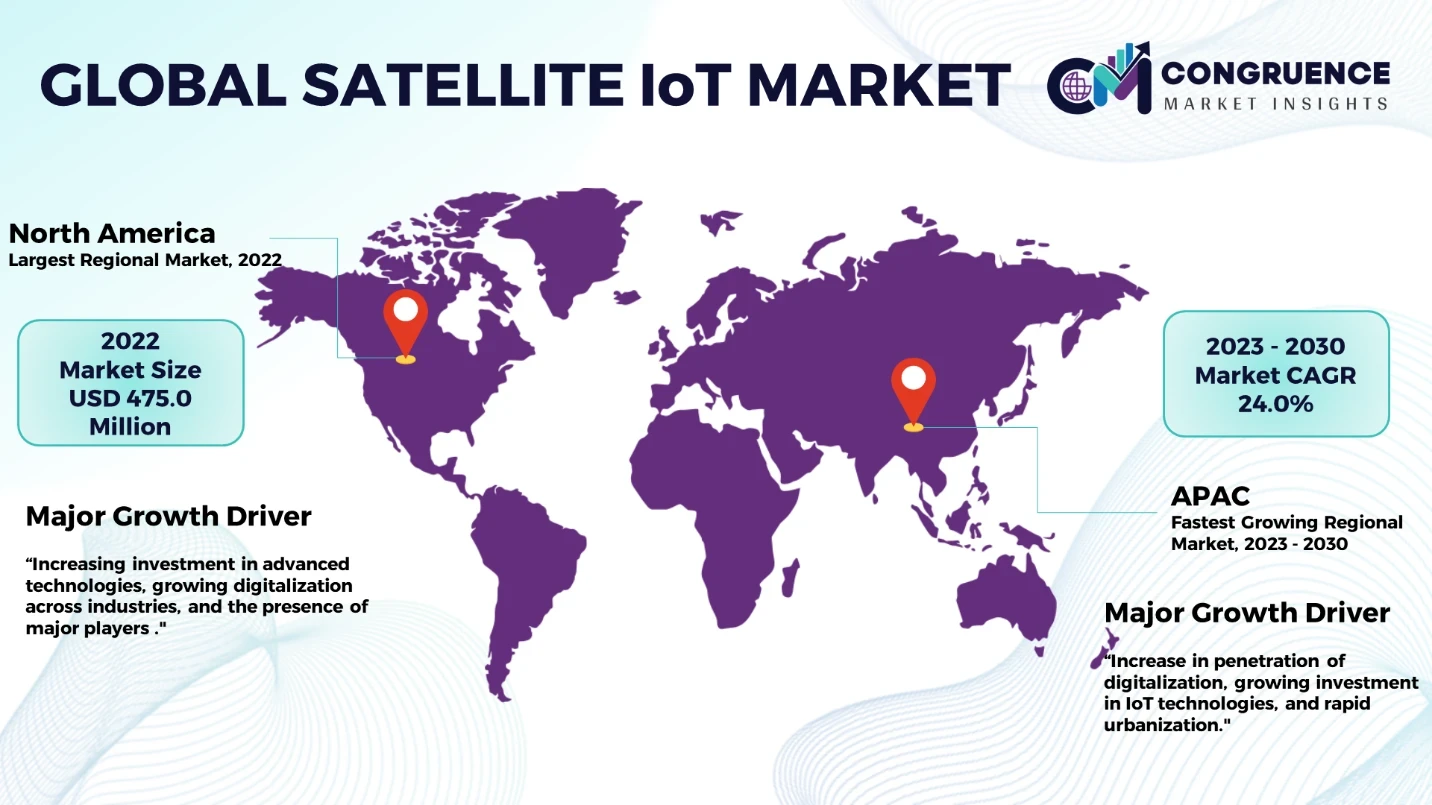Reports
The Global Satellite IoT Market was valued at USD 1,175.8 Million in 2022 and is anticipated to reach a value of USD 5,999.4 Million by 2030 expanding at a CAGR of 22.8% between 2023 and 2030.
Satellite IoT refers to the use of satellite network technology to provide connectivity and communication for through the internet of things ecosystem. It uses satellite communication networks and services to connect terrestrial IoT sensors and IoT devices to a server. It provides appropriate connectivity for sensors and devices, in remote areas. The satellite IoT network enables devices to send data to the main servers and receive updates from them through two-way communication. Satellite IoT connects devices to the internet through satellite instead of traditional cellular network. It offers several benefits including global coverage, reliability, low power consumption, low latency, and secure communication among others. On the basis of service type, it can be classified into direct-to-satellite and satellite IoT backhaul. Satellite IoT can be of great help in various industries, including agriculture, oil and gas, transportation and logistics, energy and utilities, maritime, healthcare, and others. The market is influenced by factors such as global connectivity in remote areas, growth of 5g wireless connectivity, growing use in agriculture industry, and rising demand for IoT connectivity.

Satellite IoT Market Major Driving Forces
Global Connectivity in Remote Areas: The major driving factor of global satellite IoT market is growing need for global connectivity for the IoT devices in remote areas. Various businesses use satellite IoT services to track and monitor equipment for intelligent data transfers. This is vital for the businesses operating in challenging environments, such as aviation, maritime, and rural areas.
Growth of 5G Wireless Connectivity: The global satellite IoT market is driven by the development and growth of 5G wireless connectivity. 5G network has high bandwidth capabilities that are leveraged by satellite IoT applications that require real-time data transfer. Integration with 5G networks enhances the capabilities of satellite IoT and improved the performance of satellite IoT.
Growing Use in Agriculture Industry: An increase in use of satellite IoT to automate routine process in the agriculture industry is the significant factor driving the market growth. This allow farmers to remotely monitor their crops and livestock in real-time.
Rising Demand for IoT Connectivity: The rapid growth in IoT applications across various industries fuels the demand for reliable connectivity. Satellite IoT plays a crucial role in order to address the need for connectivity in locations where traditional networks may be insufficient.
Satellite IoT Market Key Opportunities
Technological Advancements: Ongoing technological advancements in satellite technology for improved power efficiency, and cost reduction is expected to offer significant opportunities for the market expansion. Miniaturization of satellite components, advancements in antenna design, and low-power sensor technology leads to enhance device efficiency and affordability.
Businesses Reliance on IoT-enabled Services: The increase in reliance on IoT in both consumer and industrial sector is anticipated to present profitable opportunity for the market growth. In industrial applications IoT sensors are used to monitor, collect, and share data in in various industries including manufacturing, automotive, healthcare, and agriculture.
Integration with Edge Computing: Opportunities lies in the integration of satellite IoT with edge computing technologies that brings data processing closer to source. This leads to reduced latency and more efficient use of satellite bandwidth. Edge computing transform the satellite IoT market by enhancing its capabilities, and improved reliability, and resilience.
Satellite IoT Market Key Trends
· The growth in digitalization is the key trend in global satellite IoT market, as it holds immense potential to revolutionize various industries
· 5G wireless connectivity is a major trend in seamlessly integrating satellite and terrestrial networks
· The growing trend of adopting autonomous systems and connected devices in industrial sectors significantly influences the market
· The increasing demand for environmental monitoring devices owing to growing environmental safety concerns regarding climate change
· Growing demand for satellite IoT for transforming corporate sustainability is and emerging trend in the industry
· Integration of low earth orbit(LEO) satellites, characterized by their lower orbit and improved latency are gaining momentum
· Ongoing advancement in satellite technology, such as development of smaller and more cost-effective satellite platforms, and high-throughput satellite are contributing to the growth of market
Region-wise Market Insights
North America accounted for the largest market share at 40.4% in 2022 whereas, Asia Pacific is expected to register the fastest growth, expanding at a CAGR of 24.0% between 2023 and 2030.

In North America, the demand is attributed to the factors such as increasing investment in advanced technologies, growing digitalization across industries, and the presence of major players in the region. Moreover, the growing government spending on defense and communication networks, and surging demand for earth observation satellites are some factors contributing to the regional market growth. Europe emphasizes on environmental monitoring and sustainability. In addition, strong emphasis on utilizing satellite IoT for tracking deforestation, air quality, and climate change drives the market expansion in Europe. In Asia-Pacific, the market is characterized by increase in penetration of digitalization, growing investment in IoT technologies, and rapid urbanization which has created an increasing demand for satellite IoT. Furthermore, the factors including higher adoption of advanced technology, rapid growth of regional economies, and growing adoption of satellite IoT in agriculture industry are expected to boost the market growth in Asia Pacific. The Middle East and Africa has been witnessing a growing demand for satellite IoT, in South America, the market is influenced by economic factors, with growing adoption of satellite IoT in healthcare, and maritime sectors.
Market Competition Landscape
The global satellite IoT market is characterized by intense competition among a several major players. Key players in the satellite IoT market engage in strategies aimed at gaining a competitive edge. These strategies include product innovation, design differentiation, and the incorporation of sustainable and eco-friendly materials to meet evolving consumer preferences. These major companies are adopting strategic collaborative initiatives to increase their market share and profitability. Furthermore, major players are highly investing in research and development for the development of advanced and cost-effective satellite platforms in order to expand their business. Established brands leverage their reputation for quality and reliability to maintain market share, while newer entrants focus on disruptive innovations and unique selling propositions.
Key players in the global satellite IoT market implement various organic and inorganic strategies to strengthen and improve their market positioning. Prominent players in the market include:
· Iridium Communications Inc.
· Globalstar Inc.
· Orbcomm Inc.
· Sigfox
· Astrocast SA
· Myriota
· Telesat
· Eutelsat S.A.
· Airbus SE
· Thales Group
· Thuraya
· Surrey Satellite Technology Ltd.
· Inmarsat Global Limited
· Fleet Space Technologies
|
Report Attribute/Metric |
Details |
|
Market Revenue in 2022 |
USD 1,175.8 Million |
|
Market Revenue in 2030 |
USD 5,999.4 Million |
|
CAGR (2023 – 2030) |
22.8% |
|
Base Year |
2022 |
|
Forecast Period |
2023 – 2030 |
|
Historical Data |
2018 to 2022 |
|
Forecast Unit |
Value (US$ Mn) |
|
Key Report Deliverable |
Revenue Forecast, Growth Trends, Market Dynamics, Segmental Overview, Regional and Country-wise Analysis, Competition Landscape |
|
Segments Covered |
· By Service Type (Direct-to-Satellite, and Satellite IoT Backhaul) · By Frequency Band (L-Band, Ku and Ka-Band, S-Band, and Others) · By Organization Size (Large Enterprise, and SMEs) · By Industry Vertical (Maritime, Oil & Gas, Agriculture, Healthcare, Energy & Utilities, Transportation & Logistics, and Others) |
|
Geographies Covered |
North America: U.S., Canada and Mexico Europe: Germany, France, U.K., Italy, Spain, and Rest of Europe Asia Pacific: China, India, Japan, South Korea, Southeast Asia, and Rest of Asia Pacific South America: Brazil, Argentina, and Rest of Latin America Middle East & Africa: GCC Countries, South Africa, and Rest of Middle East & Africa |
|
Key Players Analyzed |
Iridium Communications Inc., Globalstar Inc.,Orbcomm Inc.,Sigfox,Astrocast SA,Myriota,Telesat,Eutelsat S.A.,Airbus SE,Thales Group,Thuraya,Surrey Satellite Technology Ltd.,Inmarsat Global Limited, and Fleet Space Technologies |
|
Customization & Pricing |
Available on Request (10% Customization is Free) |
